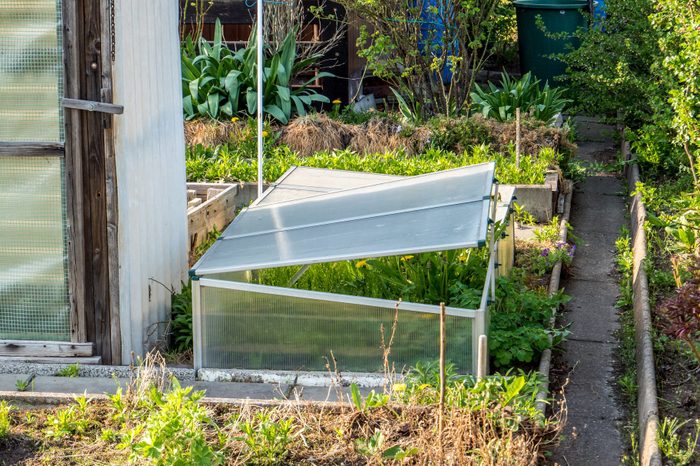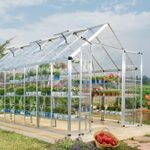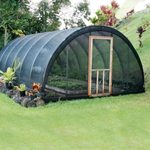What Is a Cold Frame Greenhouse?

Gardening pros don't consider a cold frame a greenhouse, but they agree cold frames are highly useful. Learn more and consider if one is right for you.
Our editors and experts handpick every product we feature. We may earn a commission from your purchases.
Space is limited in my greenhouse in U.S. Department of Agriculture Plant Hardiness Zone 7a. Instead of knocking it down and building a bigger one, several years ago I assembled two cold frame greenhouses from kits and placed them against the structure. I’m glad I did.
Whether you have a big garden or a small one, you can probably benefit from a cold frame greenhouse. Here’s what you need to know.
On This Page
What Is a Cold Frame Greenhouse?
A cold frame greenhouse is a type of mini-greenhouse with no bottom, so you can place it in a garden bed, on a raised bed or another surface. (Mine are in my driveway.) They have transparent roofs made of glass, plastic sheets or multi-wall polycarbonate sheets. Gardening pros don’t consider them true greenhouses — they’re too small — but they work in a similar fashion.
Space requirements determine the size. My cold frames are four feet by four feet because those are the sizes of the raised beds they’re on. Three to four feet wide is easy to reach across for harvesting and planting. Most cold frames are low to the ground to better retain heat.
The sides of a cold frame are built at an angle to shed rain and snow and capture the most sunlight. My cold frame sides are also transparent to capture more light. A hinged top lets you harvest crops or raise it for ventilation on warm days.
Although the frame is often made of wood, other popular materials include brick and aluminum. Straw bales or concrete blocks topped with an old window can be used for an impromptu cold frame.
Benefits of a Cold Frame
Like actual greenhouses, cold frames absorb sunlight and build up heat. That creates a microclimate five to 10 degrees warmer than outdoors but cooler than inside your heated home or greenhouse.
Some plants, like salad greens, don’t need the supplemental heat of a greenhouse, but only a little more warmth than what’s outside. Long-season crops like carrots and parsnips are great to start in fall, then overwinter in a cold frame for harvest in spring.
You also can use a cold frame to slowly acclimate plants you’ve started indoors to the outdoors (aka hardening them off) before transplanting them outside in spring. Cold frames help keep those plants from getting too much wind before they’re ready. Leafy greens like lettuce, spinach and kale benefit from the few extra degrees inside a cold frame.
How To Use a Cold Frame
Cold frames can be used in various ways:
- In spring, grow seedlings to be transplanted later into the garden after the danger of frost has past.
- Plant seeds directly into the soil or into pots for transplanting later. If you’re growing transplants, bury the tray of pots halfway into the soil to protect them as much as possible.
- Overwinter plants that are tender perennials in your Plant Hardiness Zone. They won’t be actively growing, but you’re keeping them alive in a dormant state.
- Start and grow cold-weather vegetables to harvest in winter or overwinter until spring harvest.
What Plants Work Best in a Cold Frame
As Emily Murphy points out in her book Grow What You Love, it’s possible to garden year-round with the right equipment. Nearly all cool-season vegetables taste better with a little chill touching their leaves.
Options include:
- Cold-hardy vegetables like beets, cabbage, carrots and onions. These can be grown from seed or transplants to harvest in late autumn or held over through winter.
- Bulbs grown over the winter in containers, like tulips or crocus. They’re protected from overwatering and rotting, and pesky squirrels can’t dig them up.
- Early-season plants, like sweet peas and other seeds that require colder conditions than indoors or in a greenhouse. For sweet peas, I later remove the cold frame tops so the plants can be staked and grown to full size in my raised beds.
Tips for Using a Cold Frame
My cold frames draw radiant heat from my driveway and the greenhouse next to them. I also have a spigot in my greenhouse so my cold frames are easy to water. Here are more helpful tips:
- Place the cold frame in full sun with a southern exposure to capture the most light.
- Cold frames built on top of raised beds don’t hold the heat as well as those built low to the ground.
- Put cold frames against something like a wall or a fence on the north side to block cold winter winds.
- The area beneath your cold frame should have good drainage so plant roots don’t rot. Cold frames can be placed on gravel or garden beds.
- If you live in a cold climate, make sure it’s easy to water from a frostproof water faucet. Some gardeners place their cold frames near their kitchen so water is easily accessible.
- Seal the cold frame as tightly as possible at night to prevent heat loss.
- Install solar automatic vent openers for the lid so you don’t have to remember to open it on a warm day.
- People often use old glass windows to make cold frames. But in a climate like mine with hailstorms, polycarbonate is better.
- According to the University of Missouri Extension, placing a mat or blanket over a cold frame on really cold nights conserves heat.



